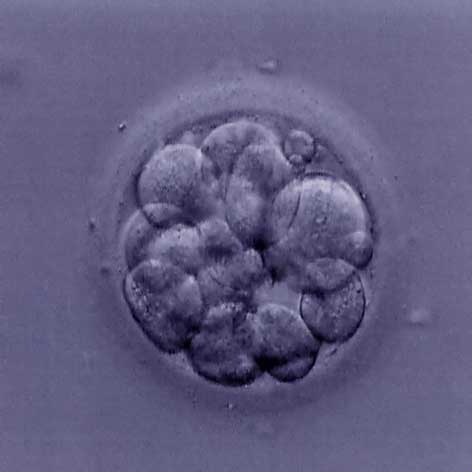 In recent decades, with the development of new biotechnologies (genetic and others) applied to the study of the first stages of embryonic development, much progress has been made in understanding how multicellular organisms originate from a single cell. However, there are still many questions waiting for answers, as is normal in science.
In recent decades, with the development of new biotechnologies (genetic and others) applied to the study of the first stages of embryonic development, much progress has been made in understanding how multicellular organisms originate from a single cell. However, there are still many questions waiting for answers, as is normal in science.
Human embryonic development is a continuous process that begins when an oocyte (egg) is fertilized by a sperm, giving rise to a fertilized oocyte that begins to divide and differentiate into different phases to give rise to the organism that gives birth to us. characterizes.
Understanding the genetic, biochemical and cellular mechanisms that occur in the different stages of embryonic development has seen many advances in recent years.
However, the first stages of embryonic development that occur between fertilization and the nidation of an embryo in the so-called blastocyst stage (composed of about 250 cells) in the maternal uterus, continue to require much more research to be understood, for example , the genetic mechanisms that lead to cell differentiation to give rise to the different types of tissues that make up the organism.
It is also still waiting for a better understanding of what causes about two-thirds of fertilized oocytes not to develop in a normal pregnancy, giving rise to miscarriages that go unnoticed.
To try to understand these and other questions, it is important that scientists can investigate human embryos, which raises and has always raised pertinent ethical questions.
The various national authorities that monitor and regulate research on human embryos have been very cautious and prudent on this matter, only allowing scientists to carry out experiments on embryos considered unfeasible or otherwise disposable.
On the other hand, new genetic engineering techniques have been developed in recent years that make it possible to edit the genome and correct genetic errors in living cells.
One such technique is called Crispr-Casp9, which has proven to be very effective in editing genes in living cell genomes. This technique uses a kind of "molecular scissors", the Cas9 enzyme (which exists in bacteria Streptococcus pyogenes), which allows scientists to cut out specific regions of DNA. FOR
For genetic editing, scientists attach a small piece of RNA (DNA-like molecule) to Cas9 that binds to the specific region of the DNA molecule they want to “edit”. Once the RNA segment is attached to the DNA that the scientists have chosen, the CAS9 enzyme cuts that piece of DNA. In this way, it is possible to cut out areas of genes with mutations that cause disease and then replace them with “normal” DNA.
The potential use of this technique to correct genetic errors in embryos in order to eliminate future genetic diseases has become a hot topic of debate in the international scientific community.
Debating this issue intensely became even more pressing when, in April 2015, a team of Chinese researchers reported that they had used Crispr-Casp9 for the first time to alter a gene called HBB (whose mutations cause a potentially deadly blood disease) in unviable human embryos that had been fertilized by two sperm, thus possessing an abnormal number of chromosomes.
By the way, this technique of genetic editing had already been used before in embryos of other animals.
However, in September 2015, a British stem cell expert, Kathy Niakan, of the Francis Crick Institute in London, asked permission from the Human Fertilization and Embryology Authority (HFEA), which regulates these issues in the UK , to perform these experiments on “normal” human embryos.
On February 1st, the HFEA responded to that researcher's request, authorizing the genetic editing of human embryos exclusively for scientific research purposes.
The authorization allows researchers at the Francis Crick Institute to carry out experiments during the first seven days of embryo development, that is, until the blastocyst stage. The implantation of these embryos in the uterus of women is prohibited.
Kathy Niakan told BBC Online, “We want to understand what genes are needed for a human embryo to develop into a healthy baby. This knowledge is very important because miscarriages and infertility are extremely common, but it is not clear why they happen”. These investigations can yield useful knowledge for solving infertility problems.
In a statement from the Francis Crick Institute, it is stated that the project will only start in a few months, as it is still necessary to obtain ethical approval. In that same press release, it can be read that “the embryos used for the investigation by the researchers will be from couples who underwent fertilization treatments vitro and that they were left with surplus embryos. The donation will be made with informed consent.”
As might be expected, this authorization triggered alerts in the international scientific community, as well as from various ethical regulatory authorities.
For example, the Portuguese National Council of Ethics for the Life Sciences underlines, in an opinion issued on this subject, that “in the absence of scientific consensus on their consequences, the potential uses of these new technologies should be approached with extreme caution using a precautionary principle that safeguards its impact on present and future generations”.
The debate on this issue should involve not only the scientific community (which is divided), but also experts in ethics, healthcare professionals, regulatory bodies, infertile patients, patients with genetic diseases, their families and the general public.
It is a matter that we must follow up and that affects us all, so we must have our own and well-informed opinion about it.
Author Antonio Piedade
Science in the Regional Press – Ciência Viva


















Comments